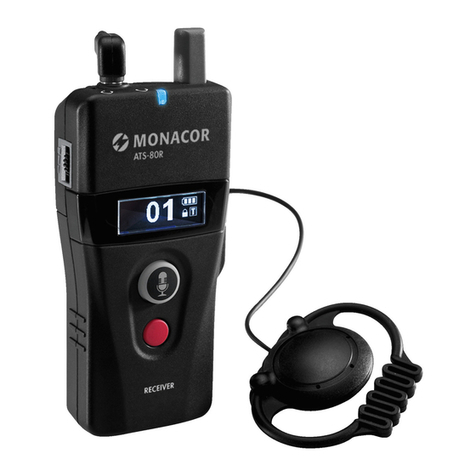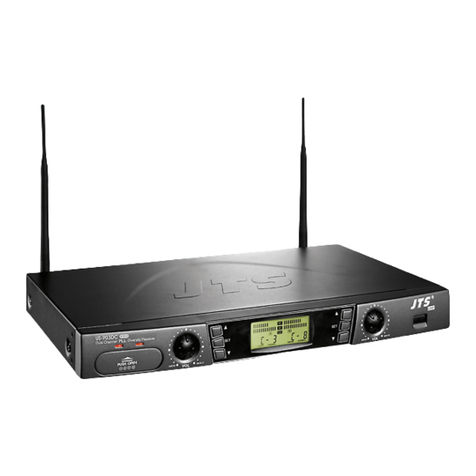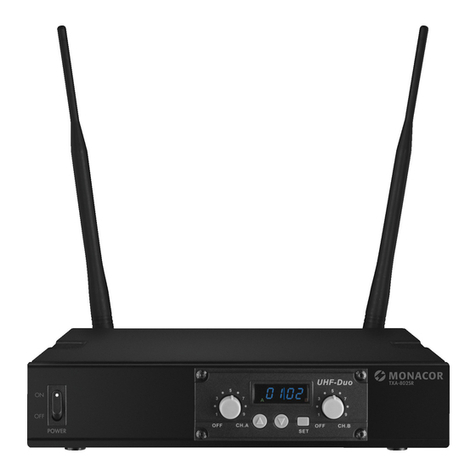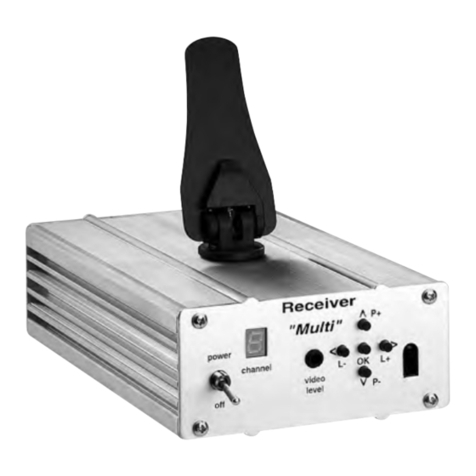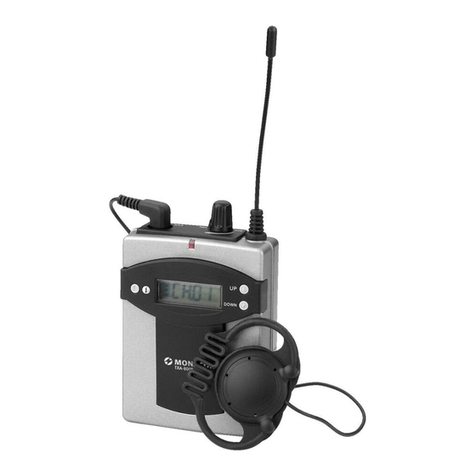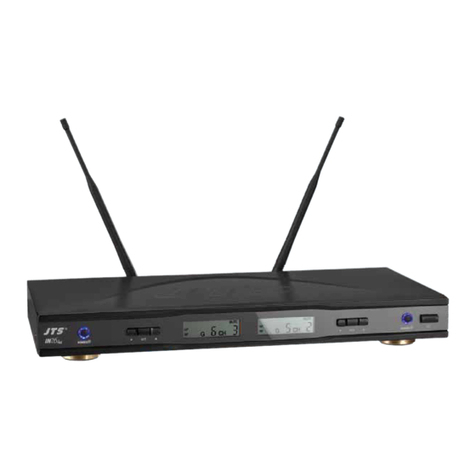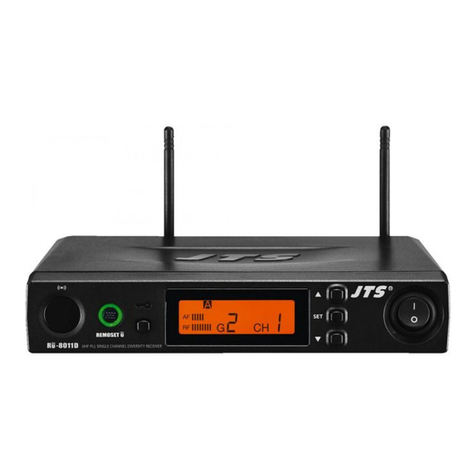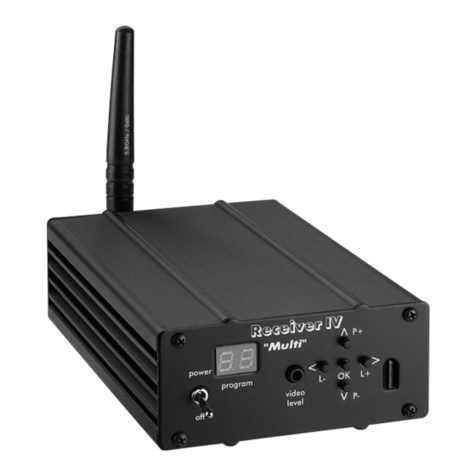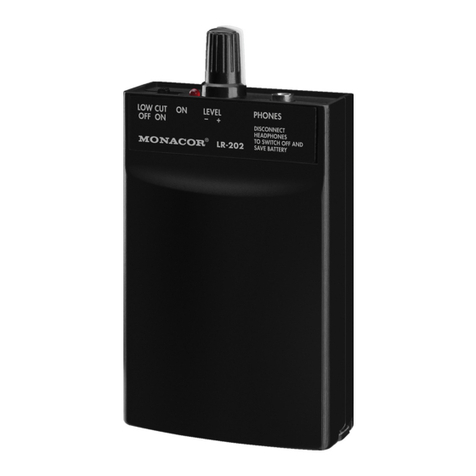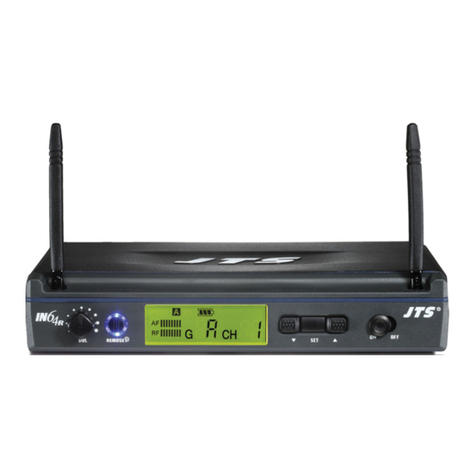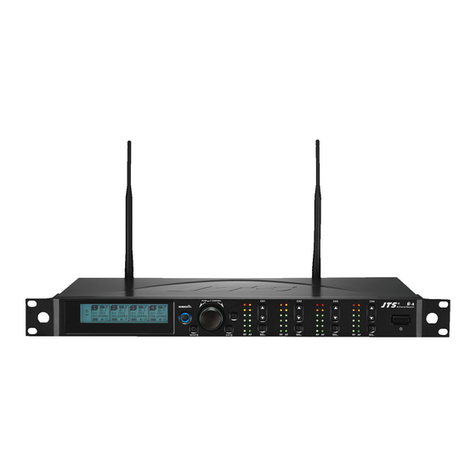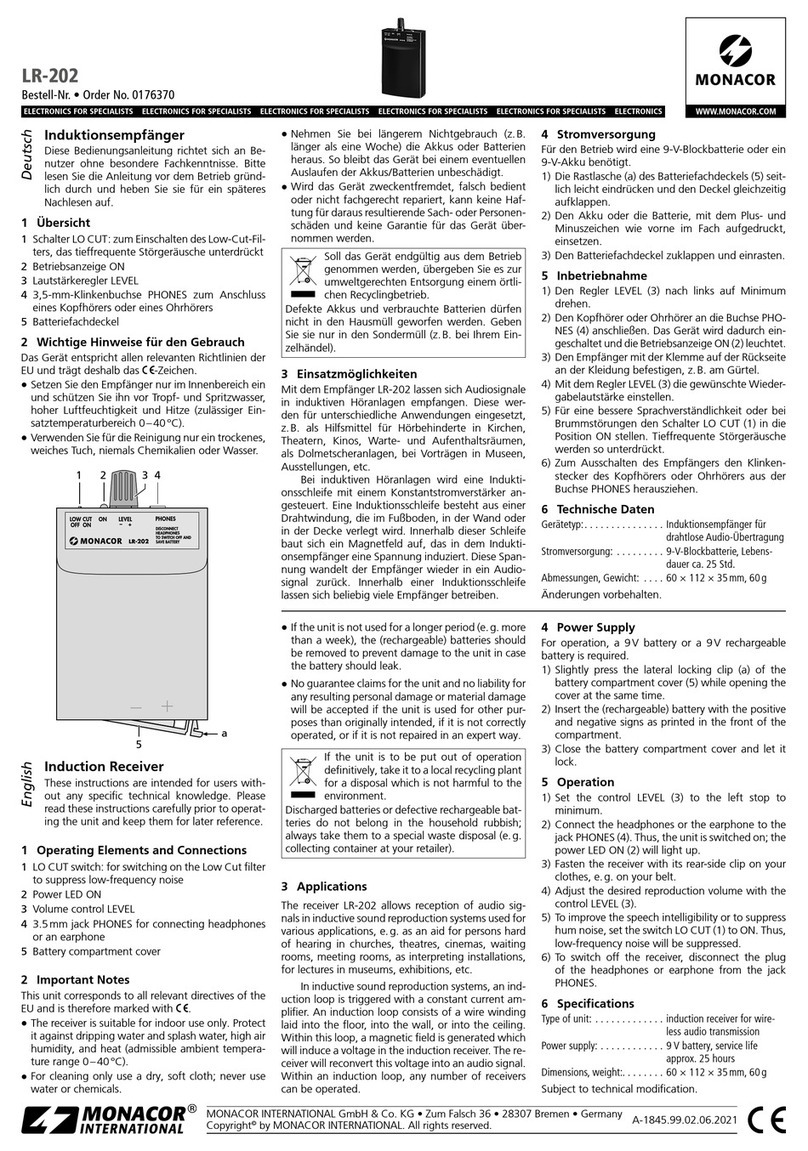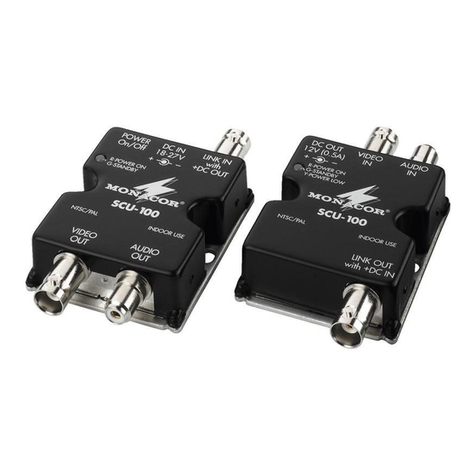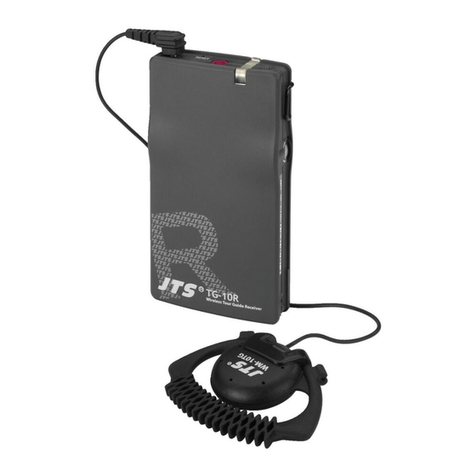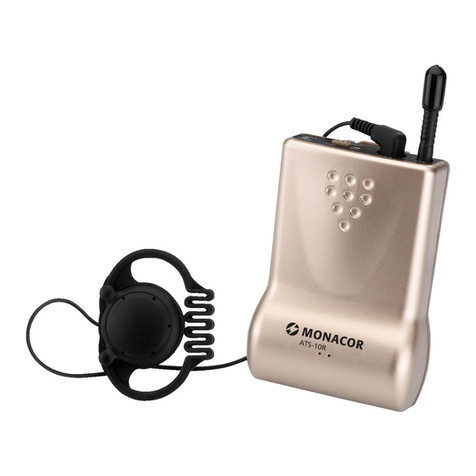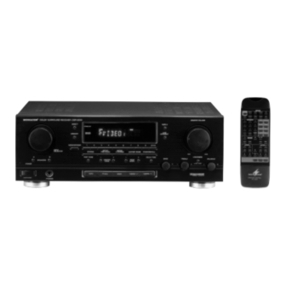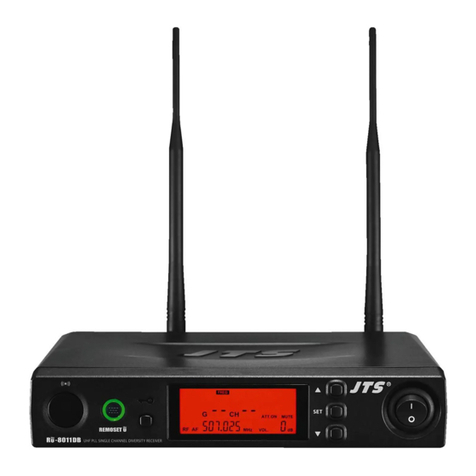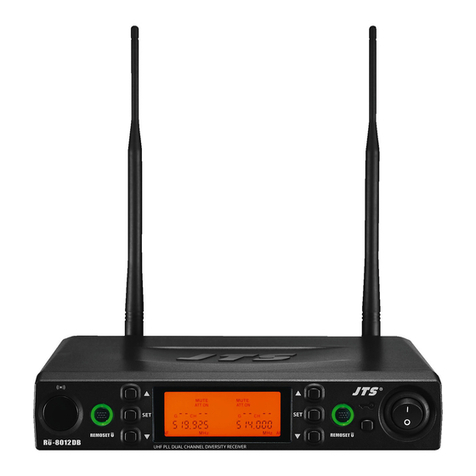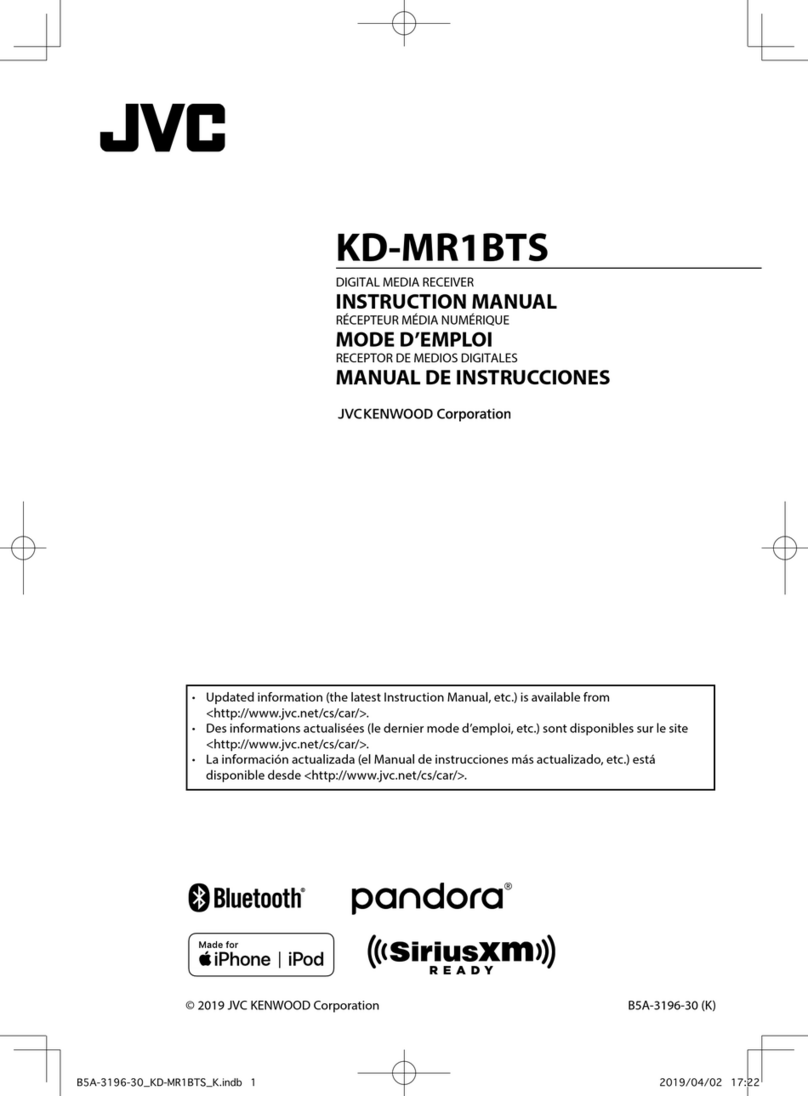Récepteur à induction
Veuillez lire entièrement cette notice d’utilisation avant
la mise en service et conservez-la pour une consulta-
tion ultérieure.
1 Eléments et branchements
1Interrupteur LO CUT : pour allumer le filtre Low Cut
qui élimine les bruits perturbateurs à basse fré-
quence
2Témoin de fonctionnement ON
3Potentiomètre de réglage de volume LEVEL
4Prise jack 3,5 PHONES pour brancher un casque
ou un écouteur
5Pince de fixation
6Couvercle du compartiment batterie
2 Conseils d’utilisation et de sécurité
Cet appareil répond à toutes les directives nécessaires
de l’Union Européenne et porte donc le symbole .
●Ne faites fonctionner le récepteur qu’en intérieur.
Protégez-le de tout type de projections d’eau, des
éclaboussures, d’une humidité élevée et de la cha-
leur (plage de température de fonctionnement auto-
risée 0–40°C).
●Pour nettoyer l’appareil, utilisez uniquement un chif-
fon sec et doux, en aucun cas de produits chimiques
ou d’eau.
●En cas de non utilisation prolongée (p.ex. supérieu-
re à une semaine), retirez les accumulateurs ou bat-
teries. L’appareil est ainsi protégé car les accumula-
teurs/batteries pourraient couler et l’endommager.
●Nous déclinons toute responsabilité en cas de dom-
mages corporels ou matériels résultants si l’appareil
est utilisé dans un but autre que celui pour lequel il
a été conçu, s’il n’est pas correctement utilisé ou s’il
n’est pas réparé par une personne habilitée ; en ou-
tre, la garantie deviendrait caduque.
3 Possibilités d’utilisation
Avec le récepteur LR-200, on peut recevoir des si-
gnaux audio dans des installations auditives inducti-
ves, utilisés pour diverses applications, p.ex. comme
aide pour des personnes à audition déficiente, dans
des églises, théâtres, cinémas, salles d’attente, de
réunion, comme installations pour interprètes, pour
des conférences dans des musées, expositions …
Dans des installations auditives inductives, une
boucle d’induction est gérée avec un amplificateur à
courant constant. Une boucle d’induction se compose
d’un enroulement de fil placé dans le sol, le mur ou le
plafond. Au sein de cette boucle, se crée un champ
magnétique qui induit une tension dans le récepteur à
Lorsque l’appareil est définitivement retiré
du service, vous devez le déposer dans une
usine de recyclage à proximité pour contri-
buer à son élimination non polluante.
Ne jetez pas les batteries usagées et les accumula-
teurs défectueux dans la poubelle domestique, dé-
posez-les dans un container approprié ou rapportez-
les chez votre détaillant.
Ricevitore ad induzione
Vi preghiamo di leggere attentamente le presenti istru-
zioni prima della messa in funzione e di conservarle
per un uso futuro.
1 Elementi di comando e collegamenti
1Interruttore LO CUT: per attivare il filtro Low-Cut
che sopprime le interferenze a bassa frequenza
2Spia di funzionamento ON
3Regolatore volume LEVEL
4Presa jack 3,5mm PHONES per il collegamento di
una cuffia o di un auricolare
5Clip
6Coperchio del vano batteria
2 Avvertenze di sicurezza
Quest’apparecchio è conforme a tutte le direttive ri-
chieste dell’UE e pertanto porta la sigla .
●Far funzionare l’apparecchio solo all’interno di lo-
cali. Proteggerlo dall’acqua gocciolante e dagli
spruzzi d’acqua, da alta umidità dell’aria e dal calore
(temperatura d’impiego ammessa fra 0 e 40°C).
●Per la pulizia usare solo un panno morbido, asciutto;
non impiegare in nessun caso prodotti chimici o ac-
qua.
●Se lo strumento non viene utilizzato per un tempo
prolungato (p.es. oltre una settimana) conviene to-
gliere le batterie per evitare che perdano, danneg-
giando lo strumento.
●Nel caso d’uso improprio, d’impiego scorretto o di ri-
parazione non a regola d’arte dell’apparecchio, non
si assume nessuna responsabilità per eventuali
danni consequenziali a persone o a cose e non si
assume nessuna garanzia per lo strumento.
3 Possibilità d’impiego
Con il ricevitore LR-200 è possibile ricevere segnali
audio di impianti acustici ad induzione. Tali impianti
servono per diverse applicazioni, p.es. come ausilio
per persone con problemi all’udito in chiese, teatri, ci-
nema, sale d’attesa, per impianti d’interpretariato, du-
rante conferenze in musei, mostre ecc.
Negli impianti acustici ad induzione, un loop ad in-
duzione viene comandato da un amplificatore di cor-
rente costante. Un loop ad induzione è composto da
un filo avvolto sistemato nel pavimento, nella parete o
nel soffitto.All’interno del loop si crea una campo ma-
gnetico che produce una tensione nel ricevitore ad in-
duzione. Tale tensione viene ritrasformata dal ricevi-
tore in un segnale audio. All’interno di un loop ad
induzione si possono gestire innumerevoli ricevitori.
4 Alimentazione
Per il funzionamento è richiesta una batteria (ricaricabile
o no) di 9V (p.es. NIMH-100/9V della MONACOR).
1) Esercitare una leggera pressione laterale sulla lin-
guetta (a) del coperchio del vano batteria (6)
aprendo contemporaneamente il coperchio.
2) Inserire la batteria con il positivo e negativo come è
stampato nel vano stesso.
3) Richiudere il coperchio del vano batteria fino allo
scatto.
5 Messa in funzione
1) Girare il regolatore LEVEL (3) a sinistra sul minimo.
2) Collegare la cuffia o l’auricolare con la presa
PHONES (4). In questo modo si attiva l’apparecchio
e la spia di funzionamento ON (2) si accende.
3) Con il clip (5), fissare il ricevitore ai vestiti, p. es. alla
cintura.
4) Impostare il volume desiderato con il regolatore
LEVEL (3).
5) Per migliorare la comprensione della lingua parlata
o in caso di ronzii, portare l’interruttore LO CUT (1)
in posizione ON. In questo modo si sopprimo le in-
terferenze a bassa frequenza.
6) Per spegnere il ricevitore staccare il connettore della
cuffia o dell’auricolare dalla presa jack 3,5mm (4).
6 Dati tecnici
Tipo dell’apparecchio: . . . . ricevitore ad induzione
per trasmissione audio
senza fili
Temperatura d’esercizio: . . 0–40°C
Alimentazione: . . . . . . . . . batteria 9V, urata 25h ca.
Dimensioni: . . . . . . . . . . . . 63 x 100 x 29mm
Peso: . . . . . . . . . . . . . . . . . 100g
Con riserva di modifiche tecniche.
Non gettare le batterie scariche o difettose
nelle immondizie di casa bensì negli appo-
siti contenitori (p.es. presso il vostro rivendi-
tore).
Se si desidera eliminare l’apparecchio definitiva-
mente, consegnarlo per lo smaltimento ad un’istitu-
zione locale per il riciclaggio.
123 4 5
6a
I
F B CH
induction. Le récepteur convertit de nouveau cette
tension en un signal audio. Au sein d’une boucle d’in-
duction, on peut faire fonctionner un nombre quelcon-
que de récepteurs.
4 Alimentation
Pour le fonctionnement, une batterie 9V ou un accu-
mulateur 9V est nécessaire (p.ex. NIMH-100/9V de
MONACOR).
1) Enfoncez légèrement sur le côté la languette (a) du
couvercle du compartiment batterie (6) et simul-
tanément, ouvrez le couvercle.
2) Placez l’accumulateur ou la batterie en respectant
les symboles plus et moins comme indiqué sur
l’avant du compartiment.
3) Remettez le couvercle en place et enclenchez-le.
5 Fonctionnement
1) Tournez le réglage LEVEL (3) vers la gauche sur le
minimum.
2) Reliez le casque ou l’écouteur à la prise PHONES
(4). L’appareil est alors allumé et la LED ON (2) té-
moin de fonctionnement brille.
3) Fixez le récepteur avec la pince (5) à un vêtement,
par exemple la ceinture.
4) Avec le réglage LEVEL (3), réglez le volume de res-
titution souhaité.
5) Pour une meilleure compréhension des propos, ou
en cas de ronflements, mettez l’interrupteur LO
CUT (1) sur la position ON. Les bruits perturbateurs
à basse fréquence sont ainsi éliminés.
6) Pour éteindre le récepteur, retirez la fiche du cas-
que ou de l’écouteur de la prise jack 3,5 (4).
6 Caractéristiques techniques
Type d’appareil : . . . . . . . . récepteur à induction
pour une transmission
audio sans fil
Température fonc. : . . . . . . 0–40°C
Alimentation : . . . . . . . . . . batterie 9V, durée de vie
25 heures environ.
Dimensions : . . . . . . . . . . . 63 x 100 x 29mm
Poids : . . . . . . . . . . . . . . . . 100g
Tout droit de modification réservé.
